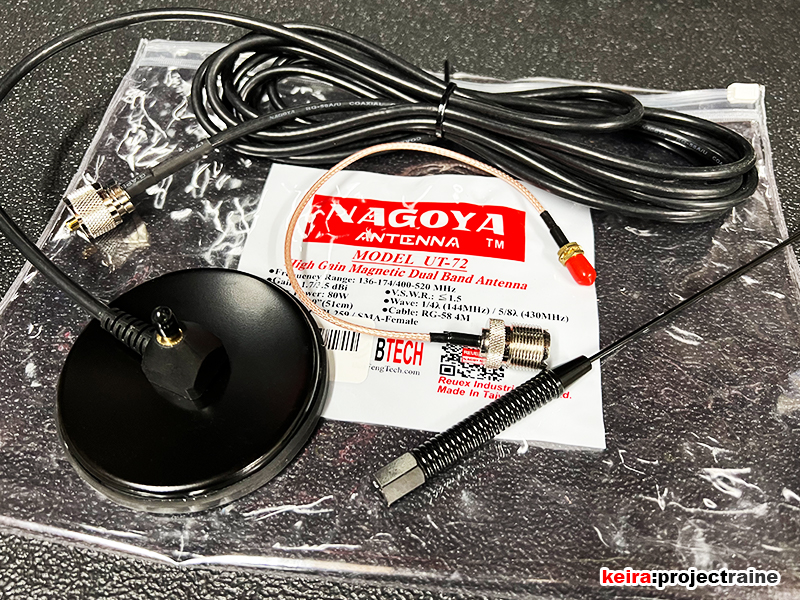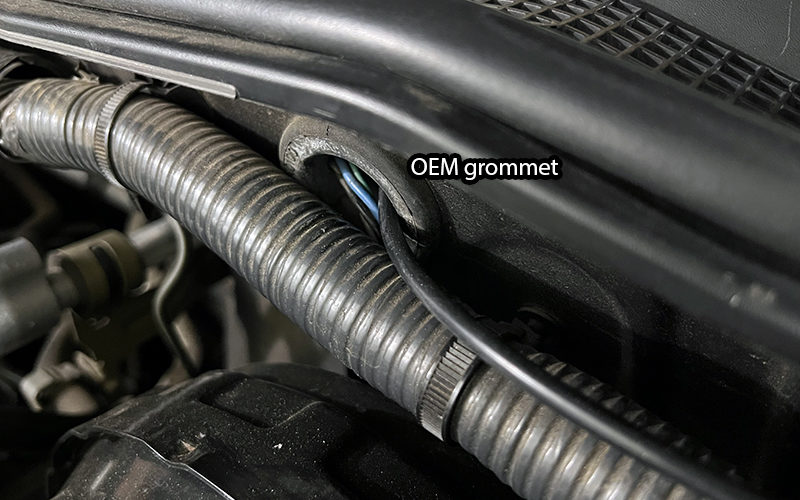No Ugly Magnet Mounts Here, Buddy: Custom GMRS Antenna Install
So here we are, with part 1 (installing the main radio unit) and part 2 (custom handset plug) done, and now it was time to do the third and final part of this Midland MXT-275 project: the antenna. The antenna included with the MXT-275 was a basic magnet-mount style antenna, which though convenient for most, looks too “temporary”. Those who have followed my build will have noticed that many times I try to keep things looking OEM or I try to hide the mods in a way that they either disappear, blend in, or function like it was OEM, and the GMRS antenna was a perfect opportunity to do some custom DIY again.
To start, I ditched the short Midland antenna for this: a genuine Nagoya model #UT-72 High-Gain Dual-Band Antenna with Magnetic Mount:

The UT-72 is a well recommended 20″ antenna that is compatible with the GMRS frequency range and features a spring-loaded removable mast, long 4-meter cable, and… a large magnetic mount. However – that large (and heavy) magnetic base was the first to go in the trash because the only part I was concerned with was the antenna coupling itself:

If you haven’t guessed it by now, let’s reqind: a long time ago I custom installed a Firestik NGP antenna in the OEM FM antenna’s location. That CB antenna mod has long since been removed, but the idea was not lost, because after some brainstorming about this GMRS antenna I realized that the only mod I would be happy doing was to custom install the GMRS antenna in the exact same location! With the plan in my head, the mod was reduced to only three items – the Nagoya coupler, a spare OEM Nissan antenna base, and an extra OEM Nissan antenna cover, as shown here:

Unlike the previous CB antenna mod, due to the fact that the Nagoya coupler and antenna were a lot smaller (and a lot lighter) compared to the old Firestik antenna, I wouldn’t have to custom fab a bracket from scratch as I did with the CB antenna. Instead, I determined that I could mod the OEM antenna base in order to mount the Nagoya antenna coupler onto it. This turned out to be a lot easier than I imagined; I started by using my trusty Dremel to chop off the top part of the OEM antenna to compensate for the Nagoya coupler:

…I then tapped and threaded the Nagoya coupler in place. Doing it this way did two things – it gave the Nagoya antenna a solid, secure bolt-on mount, and it made sure that the actual angle of the antenna mast would match that of the OEM antenna it was replacing:

Here’s a photo showing the modded OEM antenna base (on the left) next to the OEM antenna base (still mounted to the chassis, on the right) during fitment testing:

After swapping the antenna bases, it turned out that the Nagoya coupler’s square outer shape was getting in the way of the OEM cowl trim and antenna cover, so I carefully reshaped the plastic portion to a more compatible round profile. After that, I reinforced the mount by adding some epoxy clay/putty to secure the Nagoya coupler to the OEM antenna base (not sure why it looks like that in the photo, but the white/grey stuff at the bottom is epoxy). This rounded shape allowed for the cowl to be reinstalled correctly:

The antenna cable was secured to the inside of the cowl and I ran the cable to the left side of the engine bay, to exit out of the factory wiper harness grommet, eventually going through the firewall on the driver’s side:

Inside the cabin, the Nagoya antenna cable was connected to the Midland radio cable just below the driver’s side knee panel, for easy access just in case:

Mod completed! Just like back in July of 2015, I completed a new antenna mod… except for this time instead of CB it was now GMRS! The shorter, thinner GMRS antenna kept the OEM look much better than the thicker CB antenna before it. Here’s what the chunky CB antenna mod looked like 6 years ago:

…and here’s what the new GMRS antenna looks like now – it has that aftermarket “shorter antenna” feel:

I live in suburbia so I have yet had a chance to test long-range communications with the new setup (hopefully soon!), but during a caravan trip the shorter range transmissions (within a 1-mile distance between vehicles on open freeway) were nice and clear and static-free.